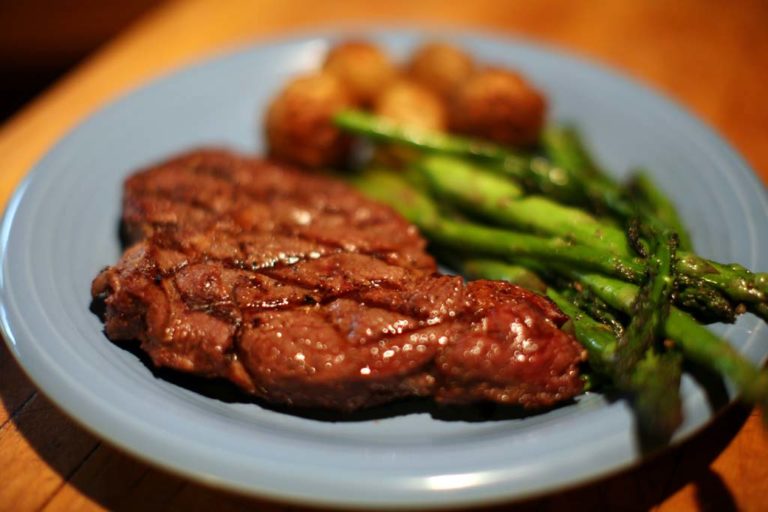
Chef's notes:
These steaks were sold to me as bison ribeyes. But they look, at least to me, more like bison rib steaks. Either that or they came from a very small bison, which is totally possible. Either way, they are steaks from some part of the rib section of a bison, and they were very tasty. The farm I bought these steaks from is kind of a small operation, and I think occasionally the meat that I get from them is processed a little hastily, but it always tastes good. That in combination with the fact that I am supporting a small local business is enough to keep me buying from them.
Bison steaks should be seasoned very simply, with salt and pepper. But make sure it’s good salt and good pepper—coarse sea salt and fresh cracked black pepper.
Ingredients
- 3 bison rib steaks
- Sea salt
- Black pepper
- Vegetable oil
- Butter for serving (on top)
Grilled Bison Steak: Seasoned Simply with Sea Salt and Black Pepper
- Pick up some bison rib steaks. As I said above in the introduction, I purchased these bison rib steaks from a local farm that was selling meat at the farmers market. It came frozen in cryovac packaging, which is the most common way to find bison meat. You may occasionally find it fresh or at least thawed at some bigger butcher shops. I know Whole Foods sells it that way.
- Season the bison rib steaks. I season my bison steaks very simply, just like beef steaks. The key here is to use really good salt and really good pepper. I have 8‒10 varieties of salt on hand at all times. Most of the time I end up using a coarse sea salt and fresh cracked black pepper. But occasionally I use kosher, Sel Gris, or Fleur de Sel. And sometimes I use a little white, red, or green pepper, but not too often. Lastly, rub a little vegetable oil on the steaks. This will keep them from sticking.
- Heat up the grill and get it ready. I have found that most gas grills are vastly underpowered, which is why I usually use a charcoal grill. But today I am using this gas grill if only to figure out a way to make it work. With a few modifications and a little ingenuity, I made this grill hotter than it has ever been before. Below I give a detailed play-by-play on how I did that. Lightly oil your grates and get to grilling.
- Grill the bison rib steaks on the first side. Once the grill is up to heat, lay the steaks on the grates over the flames. Let them sit for 3‒4 minutes while they develop grill marks. Then rotate the steaks 45 degrees and move them to a fresh piece of grill grate to complete the grill marks. You move the steaks to a fresh piece of grate to make the grill marks quickly. Otherwise the meat will sit on the grill too long and it’s quite possible you’ll overcook them.
- Flip the steaks and grill the second side. The point at which you flip will depend entirely on how well done you like your steaks. The trick is to get a feel for how steaks cook in your grill. Touch the steaks with your finger and feel how the meat changes as it cooks. It is impossible to use time as a gauge for when the steaks will be done. Using temperature as a guide is the best way to tell, and the way it feels is the second best. The section below provides some temperature guidelines for cooked steak.
Tips & Tricks
- Sometimes turning off all but one burner will make the last burner hotter.
- Many gas grills have a removable metal covering that cover the flames to keep them from getting caked up with grease. This tin covering, once removed, will make the grill much hotter.
- Finding some way to lower the grates closer to the flame will get the grilling area hotter.
- I am not sure that this next one is recommended by the gas grill companies, or that it is even that safe, so try at your own risk. But I have added charcoal to gas grills to get them hotter. And it worked really well.
- Use a digital thermometer to test the internal temperature of the steaks. For rare meat, look for 120–125 degrees F, medium is 140–150 degrees F, and well done is around 160–170 degrees F.
